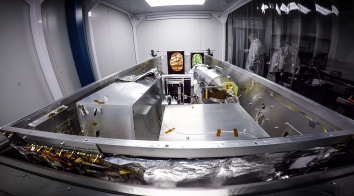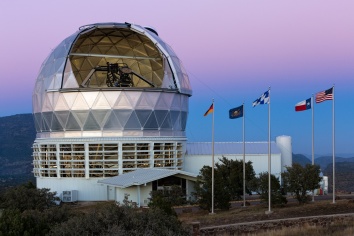Astronomers Disprove Planet Orbiting Nearby Barnard’s Star
18 May 2021
FORT DAVIS, Texas — Astronomers are announcing today that they have disproved a 2018-announced planet orbiting Barnard’s Star, the second-closest star to our Sun. The findings, based on observations with the Habitable Zone Planet Finder (HPF) instrument on the 10-meter Hobby-Eberly Telescope at The University of Texas at Austin’s McDonald Observatory, have been accepted for publication in The Astronomical Journal.
Led by University of California, Irvine graduate student Jack Lubin, the large international team also includes UT Austin astronomers Michael Endl and William Cochran.
The team said that archival data and new observations from HPF do not show signs of a planet in the Barnard’s Star system. Instead, the astronomers suggest signals initially appearing to be from a “super Earth” measuring 3.3 times the size of our home planet are more likely the result of starspots, stellar activity similar to the sunspots well known on our own Sun.
“Around the time of the 2018 exoplanet announcement, our team was actually observing Barnard’s Star as part of a commissioning operation for the new Habitable Zone Planet Finder,” Lubin said. “But the more data we collected with HPF, and the closer we looked, the more convinced we became that the proposed planet candidate is a false positive.”
Today’s disproved planet is not the first for Barnard’s star. “The star is famous — or infamous — in the exoplanet field,” Endl said. “It was one of the first stars that astronomers believed to have detected a planetary system in the 1970s and 80s. Later these results were shown to be instrumental effects.”
The 2018 planet announcement drew a lot of attention because of the cultural lore and scientific fascination around Barnard’s Star. Due to its relative lack of magnetic activity, the star has been thought to be a “Doppler standard” by astronomers. The planet finding seemed incontrovertible; the international team that announced it based their findings on more than 700 observations over 23 years with seven instruments; their results were published in Nature.
But, according to Lubin, the HPF team had some questions about the relationship between the rotation period of Barnard’s Star, which is around 145 days, and the proposed exoplanet’s 233-day orbit. “They are one-year aliases of each other, so what we think has happened is that the rotation of Barnard’s Star was sampled in a way that produced a signal at a different period,” said Lubin. “That signal was ascribed to an exoplanet that we now think is not there.”
Also, features on the surface of stars, such as starspots, can cause signals in astronomical observations that mimic a planet’s orbit, causing a false positive exoplanet detection.
Endl explained that earlier studies hinted at magnetic interference going on with Barnard’s Star. “From precise radial velocity measurements that we collected more than 20 years ago using the UVES spectrograph at the Very Large Telescope in Chile, we were surprised to detect that, even for such an old star, our measurements were affected by the magnetic activity in this star,” he said. “This is typical for younger and faster rotating stars, but it was not really expected for Barnard."
The HPF team drew their conclusions after testing three different models of the Barnard’s system. In the first run, they analyzed for a single planet with the same characteristics as those in the 2018 paper with no stellar activity. Next, they ran the experiment accounting for the planet plus an additional signal of activity of the star. Then they performed on a test with no planet but with stellar activity.
“We found that the model which only accounts for stellar activity fits the data the best,” said Lubin.
The team then conducted a year-by-year analysis of the signaling data from Barnard’s Star. They found that the data suggesting the presence of a planet was strongest around the middle of the dataset but weak at other times.
“Even though Jack’s result demonstrates again that stellar activity can mimic a planet, I am excited about the continued monitoring of this fascinating star with the HPF at the Hobby-Eberly Telescope and other instruments around the world,” Endl said. “I bet eventually we will find planets orbiting Barnard’s Star!”
— END —
Notes to editors: The research paper is freely available online at: http://arxiv.org/abs/2105.07005
Media Contact:
Rebecca Johnson, Communications Mgr.
McDonald Observatory
The University of Texas at Austin
512-475-6763
Science Contact:
Dr. Michael Endl
Center for Planetary Systems Habitability
The University of Texas at Austin
512-471-8312







